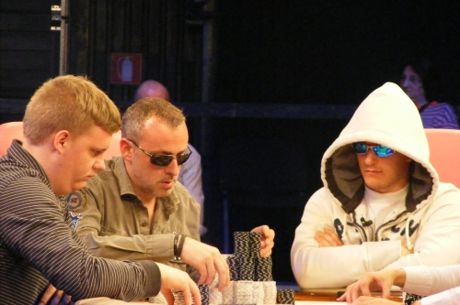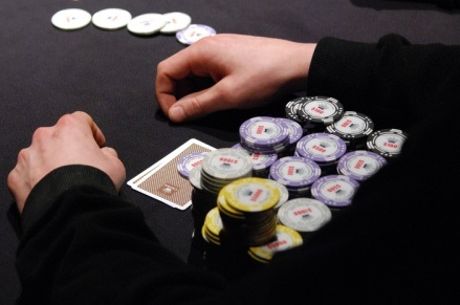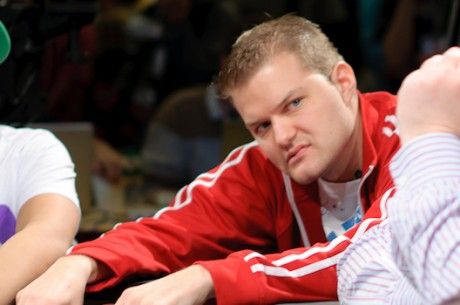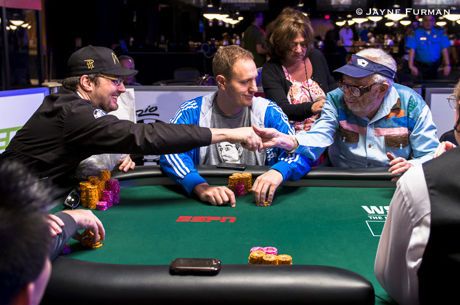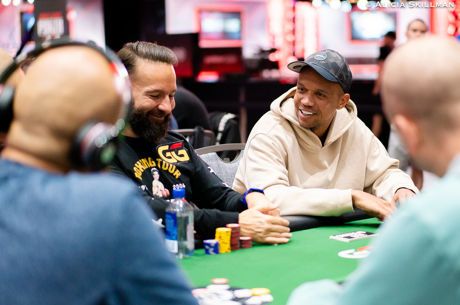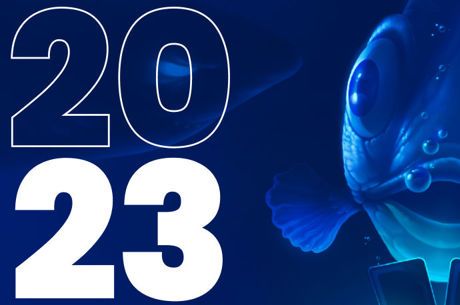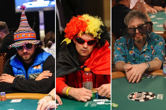Common Poker Tells - How to Read People in Poker


Table Of Contents
- What is a tell in poker?
- 1. Making eye contact, or looking away
- 2. Taking extra time to act, or acting quickly
- 3. Handling chips and/or cards
- 4. Level of attentiveness
- 5. Table talk
- Zachary Elwood's 'Beginner's Guide to Controlling Poker Tells'
- Be aware of where you look after making big bets
- Be aware of how long it takes you to bet, call, or check
- Try not to "act" during a hand
- Generally, just try to be stoic
- Poker Tells F.A.Q.
- Final Thoughts
Players who are relatively new to no-limit hold'em sometimes overvalue the importance of "poker tells."
What is a tell in poker?
By poker tells we refer to those actions, either physical or verbal, players make at the table that might give away information about the strength of their hands.
In any live poker game, especially at the lower limits, it isn't uncommon to see players revealing information via such tells without being aware they are doing so.
Players also will deliberately act in certain ways or say certain things to try to deceive their opponents, and thus might give away information to others who are able to see through such performances.
New players are probably better off not worrying too much about deciphering other players' tells, but instead focusing on other aspects of poker strategy while trying to minimize their own tells.
In fact, when we offer the following list of "five common poker tells to look for," instead of looking for them in others, you might first look at yourself.
Think about how you act at the table and decide whether or not others might be witnessing you give off these tells.
After you've become more comfortable knowing that you aren't giving anything away, you might begin taking notice of what others are doing.

Did you know partypoker just launched an all-new version of their poker app?
Check out the best poker app of 2020 - there even a bonus for you!
Play Now1. Making eye contact, or looking away
Generally speaking, players who look squarely into your eyes during a hand are conveying strength.
Having a big hand often makes players more relaxed, and when they are more relaxed they are more likely to make eye contact than not.
Players who are weak or bluffing are usually less comfortable about the situation, and won't be so ready to look directly at you.
The flip side of this is that the players looking away from you or obviously avoiding eye contact, are those who represent relative weakness.
If they have just bet as a bluff, players will deliberately avoid engaging their opponent by looking at them.
As with all poker tells, though, in order from them to be reliable, they have to exist as part of a larger pattern of behaviours that have proven to be reliable as indicators of hand strength.
The action also has to be distinct in some way, and not part of the player's usual routine.
Some players will always stare right at you, or will always look down at their chips or community cards as hands play out.
For those players, you probably won't be able to use eye contact or the lack thereof as any sort of tell. You can learn more about what makes a good poker face here.
2. Taking extra time to act, or acting quickly
Sometimes players who are otherwise very good at hiding tells will give away a lot of information simply by varying the amount of time they take to act according to their hand strength.
These "timing poker tells" tend to work a little bit differently given the situation and the action the player ultimately makes.
If you want to learn how to read people in poker, this is one of the most common poker tells you will experience at the table.
Players who take extra time before checking often really are thinking through a decision between betting or checking.
That's an indication they "have something" — perhaps a medium-strength hand or even a strong hand, or a draw and they are considering semi-bluffing.
Meanwhile those who check quickly often really are weak.
Calling bets quickly often also indicates relative weakness, although not complete air.
Such players making quick calls after the flop frequently have drawing hands or middle- or bottom-pair type hands with which they don't want to bloat the pot.
On the other hand, taking some time before making a call is less clear-cut as a tell — sometimes these players will also have medium-strength hands or be on a draw, something you already probably suspect simply because they are calling and not raising.
Finally, poker players who bet quickly are usually thought to be on the weak side, the rapid action intended to seem intimidiating and encourage a fold.
Players who take their time before betting are generally stronger, in part because they have to think about how much they want to bet to elicit a call and extract value.
Read Also: 7 Tips to Take Your Poker Game From "Meh" to Amazing
3. Handling chips and/or cards
"When playing hands, watch their hands."
This easy-to-remember phrase reminds you to look at how opponents are handling either their chips or their cards while they play.
Once in a while, you'll see an inexperienced player's hands actually trembling when looking at cards or handling chips.
For most people, that's a true sign of nervousness — and frankly, it's almost impossible to fake "shaky hands."
More often than not, the new player who gets deep into a big pot and has shaky hands is going to be very strong, although this isn't necessarily a foolproof poker tell.
(Some people are just nervous all the time, and the hand shakes are a constant.)
How a player handles chips can also occasionally be one of those poker tells that help you read a player and put them in a range.
- Players with strong hands tend to grab chips well before the action reaches them, indicating a desire to bet.
- Players with weak hands will leave their stacks untouched.
Occasionally you'll encounter players doing the opposite of this — grabbing chips in post-flop situations in order to give the impression they want to bet, but only doing so in order to discourage you from betting because their hands are in fact weak.
Before the flop, many players will signal their intention to fold well before the action reaches them by holding their cards rather than leaving them face down on the felt.
Sometimes they'll be obvious about it, readying to muck as soon as it's their turn.
If they use a card protector, they might neglect to place it on their cards when they intend to fold. This common poker tell can even happen in multi-way pots post-flop as well.
The key, as always, is to look for a pattern in the behaviour so as to make it a more reliable indicator of what the player is going to do.
Read also: How to Play 7 Card No Peek
Play online poker games on the top online poker sites of 2021 and join thousands of other players in exciting games of Texas Hold'em, Omaha, and more!
4. Level of attentiveness
In this era of smartphones and tablets, many players bring distractions with them right to the table.
Especially before the flop, when everyone is still technically in the hand, you might take a look around to gauge the level of interest players are exhibiting.
When players start scrolling through Twitter or Facebook, that means they find them more interesting than the cards they have been dealt.
Like the players holding their cards aloft in a folding position, these players may well be less likely to get involved.
Even after the flop, some players will betray their lack of interest in the proceedings in other ways, seemingly more intent on flagging down a waiter or following the game on a nearby television screen than paying close attention to the action in the hand.
While recognizing a player's level of attentiveness may not necessarily be a good indicator of that player's specific hand strength in that particular hand, it can often tell you something more generally useful about the player's skill level.
If someone isn't paying attention at the table, that player is missing out on all of that information that you, the attentive player, are constantly gathering.
Spending time on your phone is not a good way to start if you want to know how to read poker tells and poker players in general.
Players who do that operate at a disadvantage, often without even realizing it, and might be worth targeting.
Read Also: Free Poker Sites: Where to Play Free Online Poker
5. Table talk
Talking at the table covers a huge category of potential tells. Indeed, PokerNews strategy contributor Zachary Elwood has written an entire book on the subject of Verbal Poker Tells.
We'll limit ourselves to three short points about verbal tells here.
One is the general observation that a player who is talking during a hand is often conveying how relaxed he or she is, which is usually interpreted as the player having a strong hand.
This is especially notable if the player isn't normally talkative.
Again, such a strategy can be used as a "false tell" with a player who is weak chatting away as though to give the impression of strength.
Secondly and more specifically, players will often make what Elwood describes as "disclaimers" or statements that are usually in direct opposition to their actual hand strength.
An example would be a player exhaling and saying "Well, I guess I have to play this hand" or something similar before calling or betting — kind of the verbal equivalent of a shrug.
Often this is an attempt at appearing weak when the player is actually strong.
Finally, be aware that when players talk somewhat specifically about their hands, they are very often more likely to be telling the truth than to be outright lying.
This isn't always the case, and some players are very skilled at being verbally deceptive.
But you'll often find most players are more comfortable saying what is true than what is not — so when they start talking about their hands, listen up!
Zachary Elwood's 'Beginner's Guide to Controlling Poker Tells'
Now that you know what to look for when you want to learn how to read other poker players, let's look at how you can use this information to control the way you behave at the table.
Back in 2014, published author Zachary Elwood shared with PokerNews a series of useful tips that every poker player should know. We call it the 'Beginner's Guide to Controlling Poker Tells.'
---
Winning poker, first and foremost, is about having a great long-term strategy.
It’s also about being skilled enough to understand weaknesses in your opponents’ strategies, and coming up with good strategies to take advantage of those weaknesses.
None of these fundamental things have anything to do with understanding an opponent’s physical behaviour.
That said, understanding an opponent’s physical mannerisms and verbal behaviour can give you an edge in a live poker game.
But you would do well, as a beginner, to forget completely about reading tells and concentrate on understanding fundamental poker strategy.
Because I have written books about poker tells, I’ve had many beginner-level players ask me for advice about tells and how they can get better at understanding them.
I usually tell them that they are best off forgetting about reading tells and just concentrating on improving their strategy because that is by far the more important thing.
Also, the level of play at the lowest stakes of poker is often such that you can probably keep improving your win rate just by concentrating on improving your basic strategy and by trying to understand the strategies and bet-sizing tendencies of your opponents.
Having said that, it is also true that you should concentrate on being as “unreadable” as possible.
There are some decent players at the lower limits, believe it or not, and some of them will be paying attention to your physical behaviour and what you say.
While you shouldn’t worry too much about reading others, it is valuable for you to minimize your own tells as much as you can.
Here are a few more beginner level tips for staying unreadable you can use during your next casino outing or home game:
Be aware of where you look after making big bets
After making a significant bet or raise, you should be aware of where you are looking and try to keep it consistent.
Many players have behavioural leaks where they tend to look a certain direction after betting with a strong hand or a weak hand.
For example, some players will make more eye contact with an opponent after betting a strong hand, due to being more relaxed.
Other players will avoid eye contact and look down more after betting with a strong hand.
If you are acting one way with a strong hand and another way with a weak hand, it is possible someone will pick up on this.
Many good players make a consistent effort just to look at the middle of the table after making a significant bet.
Be aware of how long it takes you to bet, call, or check
Many players have tendencies when it comes to what we call "bet-timing."
For example, some players may tend to bluff more quickly while taking longer to bet their strong hands. Or they may call a bet immediately with medium-strength hands or drawing hands.
The point here is to be aware that how long it takes you to act can be giving your opponents information.
So you would do well to wait at least a second or two before acting to be more "balanced" in your bet-timing.
Try not to "act" during a hand
Beginning players often put on an "act" in various ways, either consciously or unconsciously.
This is most often done when holding very strong hands. An example would be a player who has a very strong hand and shrugs as he makes a big bet.
Or that same player saying "I’m only betting because you checked" when betting a monster.
If you are consciously trying to do something 'tricky' behaviourally, there is a chance that more experienced players than yourself will figure out what you are doing.
Generally, just try to be stoic
You would think that staying stoic and silent during a hand would be a fairly obviously smart strategy.
But there are a lot of players, many of them pretty experienced, who do a lot of things during hands that they don’t need to do.
It’s fine to have fun at a poker table and make it a pleasant atmosphere, but be aware that if you are too relaxed, either behaviorally or verbally, during hands, you run the risk of giving information to your opponents.
Play online poker games on the top online poker sites of 2021 and join thousands of other players in exciting games of Texas Hold'em, Omaha, and more!
Poker Tells F.A.Q.
What are tells in poker?
Poker tells are changes in a player's behaviour that can give out information about the player's hand strength.
How can you tell a poker tell?
Some common poker tells, like the ones described extensively on this page, are easy to identify. Just follow the instructions in the article to know how.
Other might be more subtle. That's why you will need to observe your opponents over a long period of time and understand what are their usual reactions to poker hands and what can be identified as a poker tell.
How can you tell if someone is bluffing in poker?
Eye-contact, trembling hands, chip glance, phone glance, and table talk are only a few of the most common poker tells in poker.
Knowing how to read poker players and spot any of these poker tells will help you understand if someone is bluffing (i.e. misrepresenting the hand) or not.
Are there online poker tells?
Yes, although online poker tells are different from the live poker ones. Online poker tells have to do with factors like the bet sizing, the time spent sizing a bet, the behaviour at the table, and more.
Read this handy collection of online poker tips for more detailed information on how to become a better online poker player
What's the best book to learn more about poker tells?
You can learn more more about poker tells and how to read poker players with the Caro's Book of Poker Tells by Mike Caro, Exploiting Poker Tells by Zachary Elwood, and Verbal Poker Tells again by Zachary Elwood.
Final Thoughts
These five types of tells all come from live poker, although you should know that tells can sometimes be worth seeking out when playing online poker, too.
For some examples, see Nathan Williams' article from titled "7 Ways to Get Better Reads When Playing Online Poker."
As we noted at the beginning, some players give off tells unwittingly, but there are also players who will deliberately "act" at the table in an effort to deceive opponents with "false tells."
That means with all of the tells discussed above, you might encounter players exhibiting the tell in an effort to indicate the opposite of what it normally might signify.
For instance, a player might hold his cards in a way that makes it look like he's about to fold, encouraging you to bet, but then stay in the hand and put in a raise.
Also, take heed of that point about looking for patterns first before jumping to conclusions about an apparent tell.
Have you seen the player making eye contact on multiple occasions, then showing strong hands each time?
That might make the eye contact tell more reliable the next time you see it. But if there's no pattern against which to compare the action, be careful not to overvalue the tell.
Finally, especially for new players, it's probably much better to pay attention to betting patterns than behavioral ones — those tend to be much more dependable indicators of players' relative hand strength.
Also in this series...
- The Check-Raise
- Playing Suited Connectors
- The Fundamentals of Set Mining
- Pot Odds Basics
- Bluff Catching
- Slow Playing Do's and Don'ts
- Calculating Your Win Rate
- The Importance of Position
- Bet Sizing
Ready to take a seat at the table? Put these hold'em tips into practice at 888poker.
This first part article was originally published on July 28, 2016. Elwood's guide to poker tells was first published on October 9, 2014. Last update: December 4, 2019
Want to stay atop all the latest in the poker world? If so, make sure to get PokerNews updates on your social media outlets. Follow us on Twitter and find us on both Facebook and Google+!

In this Series
- 1 10 Hold'em Tips: The Check-Raise
- 2 10 Hold'em Tips: Playing Suited Connectors
- 3 10 Hold'em Tips: The Fundamentals of Set Mining
- 4 10 Hold'em Tips: Pot Odds Basics
- 5 10 Hold'em Tips: Bluff Catching
- 6 10 Hold'em Tips: Slow Playing Do's and Dont's
- 7 10 Hold'em Tips: Calculating Your Win Rate
- 8 Poker Positions Explained: the Importance of Position in Poker
- 9 Common Poker Tells: How to Read People in Poker
- 10 10 Hold'em Tips: Bet Sizing
